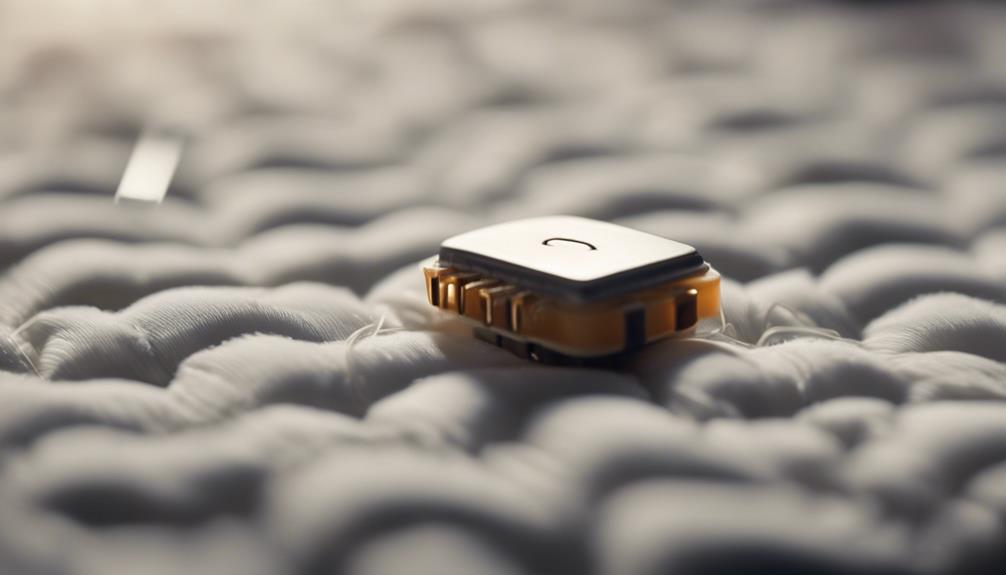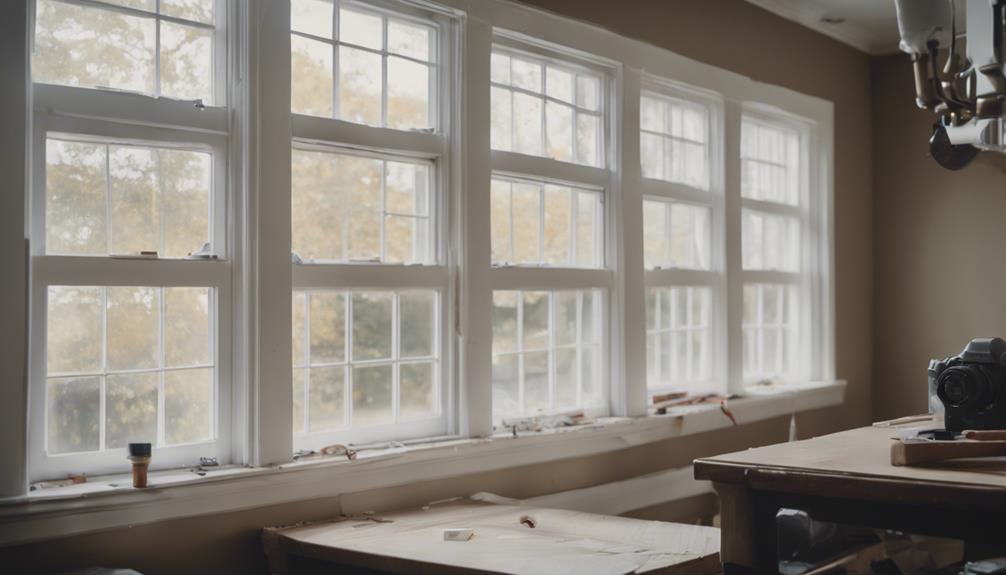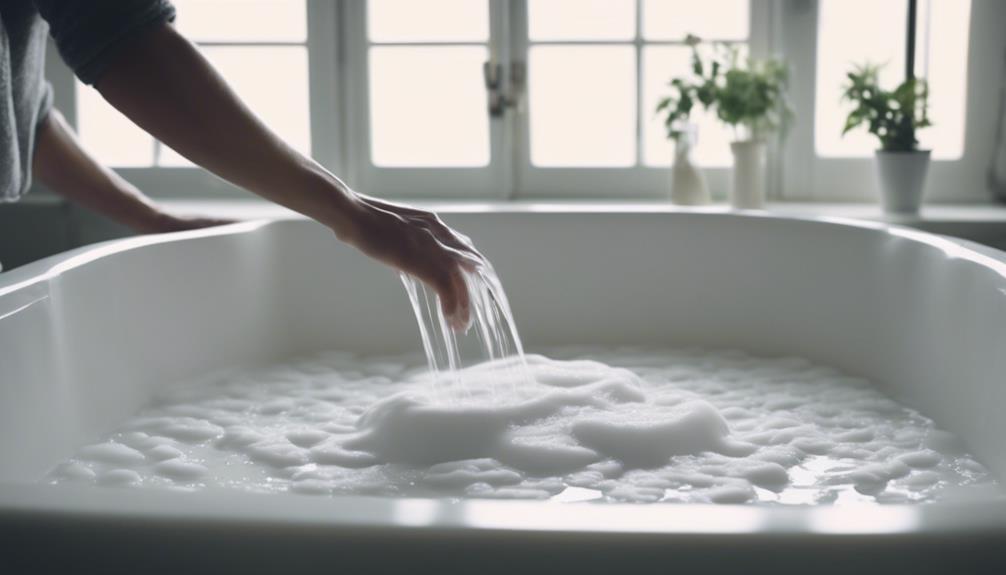When your heated mattress pad stops working, common culprits could be a faulty controller, loose connections, damaged components, power source issues, or error codes requiring attention. Check the controller for visible malfunctions like dust accumulation or wiring problems, ensuring a secure connection to the pad. Look for frayed wires or burns on components and confirm the power source is functioning correctly. If these steps don't solve the issue, consulting the product manual for error code explanations and considering a reset might help. Further details on troubleshooting steps can lead to a swift resolution.
Key Takeaways
- Examine controller for malfunctions like dust or wiring issues.
- Ensure secure connection between controller and pad.
- Check for visible damage on components like frayed wires.
- Inspect power source for issues like loose connections or voltage problems.
- Refer to product manual for error code explanations and troubleshooting steps.
Malfunction in the Controller

When troubleshooting a heated mattress pad that isn't working, the first step is to examine the controller for any signs of malfunction. In the case of a Sunbeam heated mattress pad, controller malfunction is often the culprit behind no heat output. Issues such as dust accumulation, wiring problems, or electronic component failure can lead to a breakdown in the controller's ability to regulate heat settings effectively. If the controller isn't functioning properly, it may fail to send the correct signals to the heating elements in the pad, resulting in a lack of warmth.
To address this problem, a thorough troubleshooting process is necessary to identify the root cause of the malfunction. Checking for visible damage, ensuring proper connections, and potentially resetting the controller are essential steps in this process. If the controller is indeed found to be faulty, contacting the manufacturer for repair or replacement options is recommended to restore the functionality of the heated mattress pad efficiently.
Loose Connection Between Controller and Pad
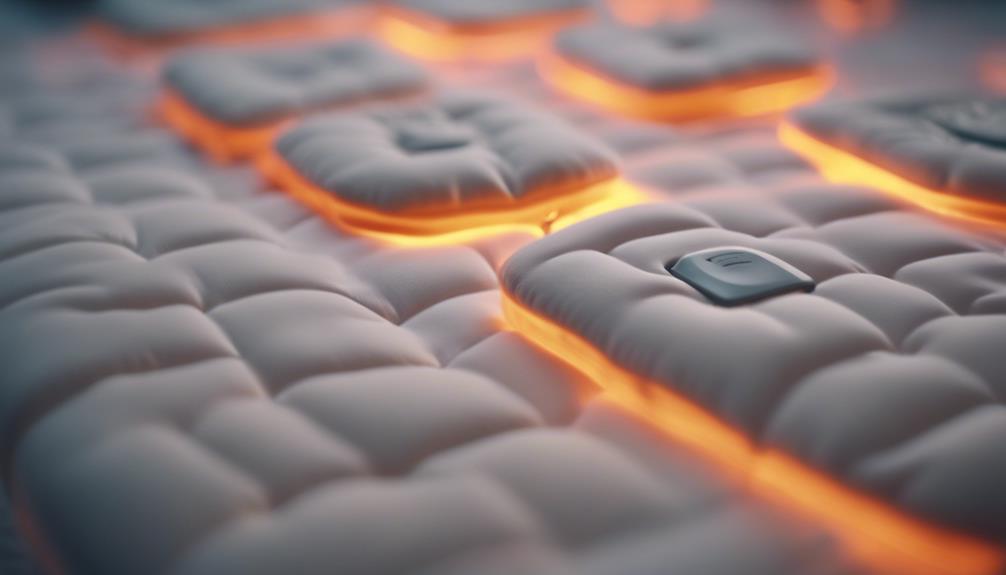
Examining the connection points thoroughly is vital to troubleshoot a heated mattress pad that has stopped working due to a loose connection between the controller and the pad. When facing issues with the heating function, the first step is to guarantee a secure connection between the controller and the pad. This can be done by checking for any visible damage on the components and making sure they're properly connected.
To troubleshoot this problem effectively, consider resetting the controller and trying different power outlets to rule out any power supply issues contributing to the loose connection problem. By inspecting the connection points carefully, you can pinpoint where the issue lies and take appropriate steps to address it. Remember that a firm and stable connection between the controller and the pad is essential for the proper functioning of the heated mattress pad.
Visible Damage on Components

Checking the controller, cord, and heating pad for frayed wires, tears, burns, or other visible damage is essential in troubleshooting a heated mattress pad that isn't working. Here are three key things to look out for:
- Frayed Wires and Burns: Examine the components closely for any fraying or burns, as these can indicate electrical issues that may be causing the malfunction.
- Melted Spots and Overheating Signs: Keep an eye out for melted spots on the heating pad or controller, and be wary of any unusual smells that could suggest overheating, which can lead to damage.
- Water Damage: Make sure there are no visible signs of water damage or exposure to liquids on the heating pad or controller, as moisture can disrupt the electrical connections and render the pad inoperable.
Any visible damage on these components can provide important clues as to why the heated mattress pad has stopped working, helping you pinpoint the root cause of the issue.
Issue With Power Source

Inspecting the power source is the next step in troubleshooting a heated mattress pad that is not functioning properly. To determine if the power source is the issue, start by plugging another device into the same outlet to check if it is functional. Confirm the power cord is securely connected to both the mattress pad and the outlet. Examine the power cord for any visible damage like fraying or cuts that may disrupt the connection. Use a multimeter to test if the power cord is delivering the correct voltage to the mattress pad. If the power source appears to be fine, consider resetting the mattress pad by unplugging it for a few minutes before plugging it back in. Below is a table summarizing the key steps to address power source issues:
| Step | Action |
|---|---|
| Check Outlet | Test with another device to verify functionality |
| Secure Connections | Confirm power cord is securely connected to both pad and outlet |
| Inspect for Damage | Look for visible damage like fraying or cuts on the power cord |
| Measure Voltage | Test voltage output with a multimeter to ensure correct delivery |
Checking for Error Codes

Upon encountering issues with a heated mattress pad, understanding the error codes becomes essential in diagnosing and resolving the malfunction effectively.
- Refer to the product manual: The first step in tackling error codes is to consult the product manual. This resource typically contains a list of error codes specific to your heated mattress pad model, along with explanations of what each code signifies.
- Troubleshoot the error code: Use the information provided in the manual to troubleshoot the error code. This may involve resetting the controller, checking the connections, or following specific instructions recommended for that particular error code.
- Consider solutions or professional assistance: Once you have identified the error code and attempted troubleshooting, assess whether the issue can be resolved with suggested solutions. If the problem persists or appears complex, it may be time to seek professional assistance to rectify the malfunction efficiently.
Inspecting for Any Damage

As we inspect the heated mattress pad for any damage, it's vital to thoroughly examine the controller, cord, and pad for any visible signs of wear or tear that may be present. Check the cord for any fraying wires or physical damage that could compromise its functionality.
Examine the controller and pad closely for burns, scorch marks, or melted areas, as these signs may indicate overheating issues. Verify that the connections between the controller and the pad are securely plugged in and not loose, as loose connections can lead to malfunctions.
Additionally, consider any recent incidents such as spills or pets chewing on the cord that may have caused physical damage to the heated mattress pad. If no visible damage is found, try resetting the pad and testing it on a different power outlet to rule out any underlying electrical issues that may be causing the problem.
Thorough inspection of these components can help diagnose and potentially resolve issues with your heated mattress pad.
Trying a Different Power Outlet
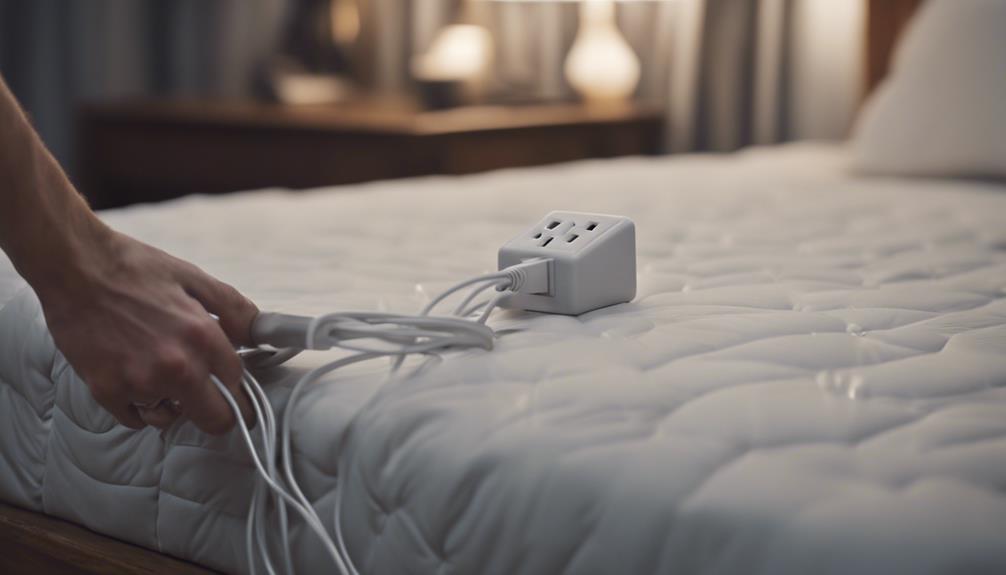
When troubleshooting a heated mattress pad that isn't working, it's crucial to prioritize trying a different power outlet as the first step.
Testing the pad on another outlet can help determine if the issue lies with the power source itself, ruling out potential problems like voltage irregularities or faulty connections.
Power Outlet Voltage Check
In order to confirm that the heated mattress pad is receiving the proper voltage, we suggest checking the power outlet using a multimeter.
- Verify the power outlet voltage matches the required voltage for the heated mattress pad.
- A standard power outlet in the US should provide around 120 volts for best functionality.
- Testing a different power outlet can help identify if the issue lies with the outlet or the heated mattress pad itself.
Checking the power outlet voltage with a multimeter is an important step in troubleshooting a malfunctioning heated mattress pad. Consistent voltage is essential for the proper operation of the pad, so making sure the outlet supplies the required voltage is key to resolving any issues.
Cord Connection Inspection
After verifying the power outlet voltage, the next step is to inspect the cord connection of the heated mattress pad for any visible damage or loose connections before trying a different power outlet. Check for any signs of cord damage or loose connections between the pad and the controller.
Make sure the power cord is securely plugged into both the outlet and the controller to establish a proper power connection. By testing the mattress pad on a different power source, such as trying a different power outlet, you can determine if the issue lies with the outlet itself.
This process helps in troubleshooting whether the problem is related to outlet issues or a potential mattress pad issue, narrowing down the root cause of the malfunction.
Considering a Reset

When troubleshooting a heated mattress pad not working, considering a reset can often help resolve the issue.
Start by unplugging the power cord and reconnecting it to initiate a reset process.
Additionally, resetting the digital control on the pad may address any functionality issues.
Power Source Check
Inspecting the power source and performing a reset can often resolve issues with a malfunctioning heated mattress pad. Here are some steps to take into account:
- Make sure the mattress pad is plugged directly into an outlet to avoid potential issues caused by extension cords.
- Try unplugging the mattress pad for 30 seconds to perform a reset and then plug it back in to see if that resolves the problem.
- Check the power source and outlet to confirm that electricity is flowing to the pad, and inspect the power cord and connections for any visible damage or loose connections. Additionally, testing the outlet with another device can help identify if the problem lies with the pad or the power source.
Control Unit Inspection
Upon observing any blinking lights or error codes on the control unit, it's crucial to investigate the connection and check for visible damage as part of troubleshooting a non-functional heated mattress pad.
Verify that the connection between the control unit and the pad is secure. Look for any signs of damage on the control unit, cord, or pad itself.
Try using a different power outlet to rule out any issues with the current outlet. If available, consult the manufacturer's instructions for a reset procedure to troubleshoot the problem effectively.
Temperature Setting Review
Confirming the accuracy of the temperature setting on your heated mattress pad is crucial for maximum comfort and performance.
- Double-check the temperature setting to make sure it aligns with your comfort level.
- Consider resetting the temperature settings to troubleshoot any heating issues.
- Verify the controller connection to the mattress pad for effective temperature adjustment.
Frequently Asked Questions
Why Would a Heating Pad Stop Working?
Heating pads can stop working due to issues like heating element damage, controller malfunctions, or connection problems. Dust accumulation in controllers can affect heat levels, while broken wires or component degradation may cause problems.
Inspecting for breaks in heating elements and testing potentiometers with a meter can help diagnose the issue. Safety concerns arise due to fire hazards, especially with older or faulty electric blankets. Understanding technical features like PTC wires can provide insights into malfunctions.
Do Heated Mattress Pads Wear Out?
Yes, heated mattress pads do wear out over time due to normal wear and tear. Continuous use and washing can degrade the heating elements, shortening the lifespan to around 5 years. Overheating, electrical issues, and physical damage can accelerate this process.
Regular maintenance, like washing before first use and proper storage, can help extend the lifespan. It's essential to follow care instructions to maximize the longevity of heated mattress pads.
How Do I Reset My Electric Heating Pad?
To reset an electric heating pad, unplug it for 30 seconds and then plug it back in. Make sure the power cord is securely connected. Look for a reset button on the controller or follow the manufacturer's instructions. Some pads may need a specific button sequence to reset.
If the issue persists, contact the manufacturer for further help. Resetting can often resolve common issues with electric heating pads.
What Causes a Heated Blanket to Stop Working?
When a heated blanket stops working, it's crucial to consider various reasons.
- Overheating from a faulty thermostat or wiring
- Dust buildup in the controller affecting heat levels
- Breaks in the heating elements
- Issues with the electrical connection like a loose cord or faulty plug
- Malfunctioning controller
It's important to troubleshoot these potential causes to determine the specific issue and address it accordingly.
Conclusion
To sum up, if your heated mattress pad stops working, it could be due to various reasons such as a malfunction in the controller, loose connections, visible damage, or issues with the power source.
By following the steps outlined in this article, you can troubleshoot and potentially fix the problem. Remember to always prioritize safety and consult with a professional if needed.
Thank you for reading and we hope this information helps resolve your issue.
